B0041VYHGW EBOK (129 page)
Authors: David Bordwell,Kristin Thompson

CONNECT TO THE BLOG
For a discussion of how various techniques of film style can function to call our attention to things, see “Gradations of emphasis, starring Glenn Ford,” at
www.davidbordwell.net/blog/?p=2986
.
Here the analyst looks for the role that style plays in the film’s overall form. Does the use of camera movement tend to create suspense by delaying the revelation of story information, as in the opening of
Touch of Evil
(
pp. 132
–133)? Does the use of discontinuous editing create a narrational omniscience, as in the sequence we analyzed in
October
(
pp. 263
–264)? Does the composition of the shot tend to make us concentrate on a particular detail (
4.140
, the shot of Anne’s face in
Day of Wrath
)? Does the use of music or noise create surprise?
A direct route to noticing function is to notice the effects of the film on our viewing experience. Style may enhance
emotional
aspects of the film. Rapid cutting in
The Birds
evokes shock and horror, while the fluctuating drone of the score in
The Prestige
creates a tense but also melancholy tone.
“There’s no scene in any movie that 50 different directors couldn’t have done 50 different ways.”
— Paul Mazursky, director
Style also shapes
meaning.
We should, however, avoid reading isolated elements atomistically, taking them out of context. As we argued on
p. 196
, a high angle does not automatically mean “defeat,” just as a low angle does not automatically mean “power.” There is no dictionary that specifies the meaning of a specific stylistic element. Instead, the analyst must scrutinize the whole film, the patterns of the techniques in it, and the specific effects of film form. For example, in
Grand Illusion,
the contrast between Rauffenstein and Elsa is heightened by Renoir’s parallel tracking shots.
CONNECT TO THE BLOG
Subtle stylistic echoes enrich
The Prestige,
as we show in “Niceties: How classical filmmaking can be at once simple and precise.”
Meaning is only one type of effect, and there is no reason to expect that every stylistic feature will possess a thematic significance. One part of a director’s job is to direct our attention, and so style will often function simply
perceptually
—to get us to notice things, to emphasize one thing over another, to misdirect our attention, to clarify, intensify, or complicate our understanding of the action. (See
“A Closer Look.”
)
One way to sharpen our sense of the functions of specific techniques is to
imagine alternatives
and reflect on what differences would result. Suppose the director had made a different technical choice; how would this create a different effect? Suppose in the scene from
Shadow of a Doubt
that Hitchcock had cut away to Little Charlie when she blurted out, “But they’re people too!” Switching our attention to her reaction might have relieved the dramatic pressure created by Uncle Charlie’s escalating bitterness, and it would have broken the steady buildup we feel in the camera movement that gradually enlarges his face.
To recall another example,
Our Hospitality
creates its gags by putting two elements into the same shot and letting us observe the comic juxtaposition. Suppose Keaton had instead isolated each element in a single shot and then linked the two elements by editing. The meaning might be the same, but the perceptual effects would vary: instead of a simultaneous presentation that lets our attention shuttle to and fro, we would have a more “programmed” pattern of building up the gags and paying them off. Or, suppose that John Huston had handled the opening scene of
The Maltese Falcon
as a single take with camera movement. How would he then have drawn our attention to Brigid O’Shaughnessy’s and Sam Spade’s facial reactions, and how would this have affected our expectations? By focusing on effects and imagining alternatives to the technical choices that were made, the analyst can gain a sharp sense of the particular functions of style in the given film.
The rest of this chapter provides an illustration of how we can analyze film style. Our example is the film whose narrative system we analyzed in
Chapter 3
:
Citizen Kane.
Here we follow all four steps in stylistic analysis. Since
Chapter 3
discussed
Citizen Kane
’s organizational structures, we will concentrate here on identifying salient techniques, locating patterns, and proposing some functions for style in each case.
A CLOSER LOOK
FILM STYLE IN
SHADOW OF A DOUBT
Uncle Charlie has come to visit his sister’s family in Santa Rosa, California. Charlie is a man of the world, flashing money freely. His sister Emmy adores him and has even named her daughter Charlie in his honor. But as Uncle Charlie lingers in town, Little Charlie begins to suspect that he’s a serial killer who preys on rich widows. She can’t prove it—the film’s title is
Shadow of a Doubt
—but she now sees his menacing side. In many scenes, director Alfred Hitchcock uses film style to link our perception and understanding of events to those of Little Charlie.
One key moment in this process comes in a scene of the family having dinner. Uncle Charlie praises smalltown living. Women keep busy in towns like Santa Rosa, he says, not like the rich, spoiled women one finds in cities. He slowly slips into a venomous monologue:
“And what do the wives do, these useless women? You see them in the hotels, the best hotels, every day by the thousands. Drinking the money, eating the money, losing the money at bridge, playing all day and all night. Smelling of money. Proud of their jewelry but nothing else. Horrible … fat, faded, greedy women.”
Reacting to this, Little Charlie blurts out, “But they’re alive! They’re human beings!” Uncle Charlie replies, “Are they? Are they, Charlie? Are they human or are they fat, wheezing animals?” As if realizing he’s gone too far, Uncle Charlie smiles and switches back to his ingratiating manner.
This powerful scene depends on many stylistic decisions about how to affect the audience. The dialogue constitutes a step in the process of strengthening Little Charlie’s suspicions that her uncle is a murderer. Since we in the audience have the same suspicions, the scene nudges us closer to the same belief. The scene suggests that he’s slightly mad; his killing proceeds not only from a larcenous bent but also from a deep-seated hatred of women. We gain a better understanding of his personality. Our response has an emotional dimension, too, since in his description of the women he dehumanizes them to chilling effect.
Within the context of the film, this scene serves several functions. The development of the story depends on Uncle Charlie’s visit to his family and Little Charlie’s growing suspicions about his murderous instincts. As Uncle Charlie points out, however, she can’t tell anyone the truth, since doing so would devastate her mother. This creates a powerful conflict, not only between Little Charlie and her uncle but also within her mind. Similarly, as she learns the truth, her attitude changes. Initially, she worships her uncle, but eventually, she becomes bitterly aware of his real nature, and her trust in the world starts to crack. The dinner scene, then, contributes to a growth in Little Charlie’s character.
Even the fact that the scene occurs at dinner is important. More cheerful scenes have taken place at the same table. At one point, Uncle Charlie gives Emmy restored photographs of their parents, which seems to convey his sincere love for her and their family. Little Charlie is exuberant
(
8.7
).
In these early scenes, we’re told of a special rapport that uncle and niece share, and he even presents here with an elegant ring
(
8.8
).
The ring plays an important role in the plot, since Little Charlie discovers an inscription on it (a clue that it came from one of her uncle’s victims). So Uncle Charlie’s hateful monologue creates a formal pattern alongside other moments we’ve already seen.
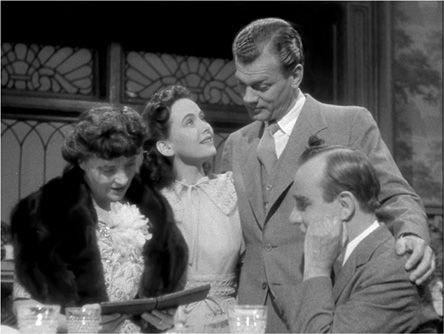
8.7 In
Shadow of a Doubt,
Little Charlie is delighted when Uncle Charlie presents pictures of her grandparents.
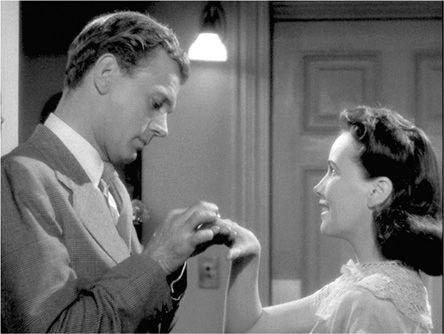
8.8 In an eerie parallel to a lovers’ engagement, Uncle Charlie presents his niece with a ring.
Hitchcock firmly believed in using the medium to arouse the viewer’s mind and feelings. So, as Uncle Charlie launches into his monologue, Hitchcock presents us with an establishing shot of the entire table
(
8.9
).
We’ve seen similar shots in earlier scenes, and it orients us to the positions of the scene’s major characters. At the same time, Hitchcock stages the scene so that Uncle Charlie rather than Emmy’s husband sits at the head of the table. His domination of the household is presented visually. As Charlie starts to talk, after a shot of Emmy we get a brief shot of Little Charlie, eying him anxiously
(
8.10
).
When he begins to denounce the “useless women,” we see a close view of him as he continues his attack
(
8.11
).
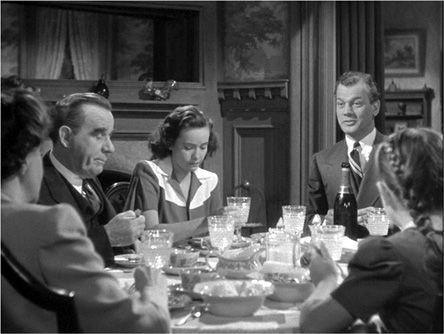
8.9 A general shot shows the family at table, with the two Charlies most visible.
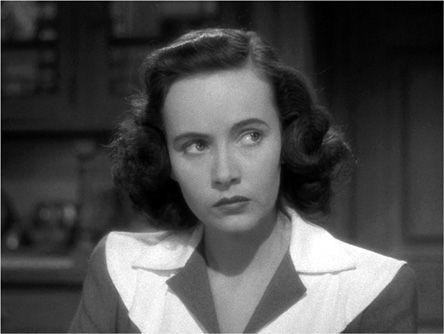
8.10 After a shot of Emmy, Hitchcock cuts to Little Charlie looking uneasily at her uncle.
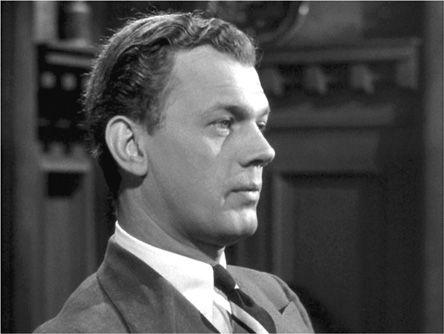
8.11 Uncle Charlie begins his monologue about useless women.
Joseph Cotten’s performance is very important here. He seethes with resentment of the “fat, faded, greedy women.” He delivers the speech without blinking, as if musing to himself rather than talking to others. Hitchcock magnifies the effect of Cotten’s performance with a tracking shot that eliminates everyone else at the table. The camera comes steadily forward, filling the frame with Uncle Charlie’s face as his monologue increases in anger and intensity
(
8.12
).
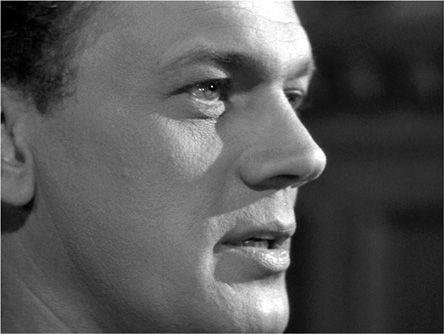
8.12 The camera moves closer to him …
Hitchcock could have used other techniques. He could have filmed Uncle Charlie from the rear, concealing his face but showing us the reactions of others at the table. He could have interrupted shots of Uncle Charlie with the reactions of Emmy, her husband, and her children. But Hitchcock achieves a specific effect by the slow, riveting movement toward Uncle Charlie’s face as his hatred for women surfaces. Even though he’s speaking the lines aloud, the relentless forward tracking movement suggests that we’re getting a glimpse into his mind.
Most directors would have shown Little Charlie objecting, “But they’re alive! They’re human beings!” by cutting to a shot of her face. But Hitchcock leaves her outburst offscreen. Then he adds an unexpected and eerie touch. As the tracking shot ends on an extremely tight close-up, Uncle Charlie turns slightly and looks into the camera as he replies, “Are they, Charlie?”
(
8.13
).
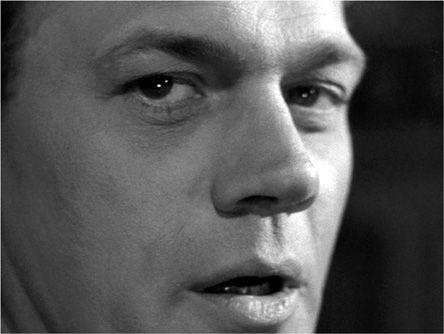
8.13 … and is very close when he turns and replies to Little Charlie’s protests that these women are human; he asks, “Are they, Charlie?”
Suddenly, we’re put in the young woman’s place, seeing the full force of her uncle’s hatred. (We’ve just seen Jonathan Demme employing a comparable technique in filming Hannibal Lecter in
The Silence of the Lambs
[
8.3
–
8.6
]. Like Little Charlie, we begin to realize that he’s a sociopath, made all the more frightening by his steady gaze and controlled speech. Hitchcock’s decisions about staging, framing, sound, and editing have intensely engaged our minds and emotions in the story.